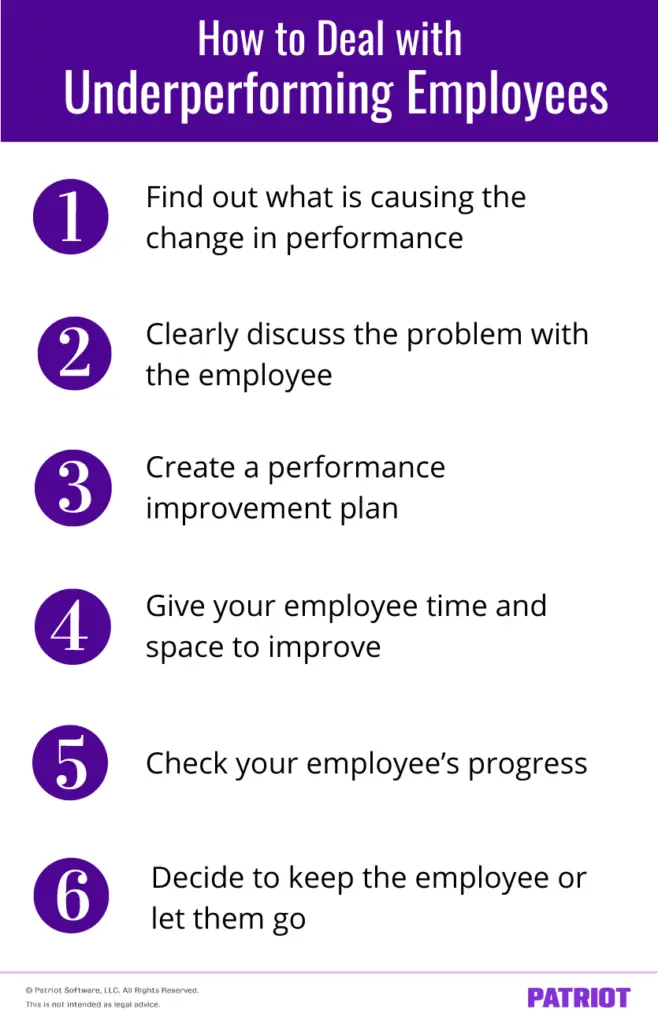In a best-case scenario, your employees operate at the highest levels of their abilities. They’re punctual, dedicated to improving, and invested in their work. When this happens, every aspect of your business benefits. But, you may have underperforming employees. And when an employee can’t do their work, others have to pick up the slack.
So, what’s a business owner to do? Instead of doing anything drastic (and costly), like terminating the employee, learn how to deal with underperforming employees.
What is an underperforming employee?
An underperforming employee is a worker that no longer works at the required level.
Types of underperformance can depend on the employee’s job. For instance, a salesperson should be attentive and kind to customers, while an electrician should follow the proper electrical codes and standards. If the salesperson ignores customers or the electrician ignores proper standards, they could be underperforming.
While underperformance can look different from job to job, there are some common behaviors to look out for. Some typical behaviors of an underperforming employee include:
- Failure to meet expected standards or deadlines
- Disruptive or unacceptable behavior
- General disregard for rules, procedures, or policies
You may be wondering, What does an underperforming employee look like on the job? Let’s look at an example. A bookstore presells 300 copies of a national bestseller. Now it’s up to the store’s shipping team to send the books out as soon as possible. There’s only one problem: The shipping manager is underperforming at their job, and packages are mislabeled or lost. Because of the shipping manager, the bookstore may have to deal with upset customers, book returns, and a loss in future sales.
How does an underperforming employee affect your business?
Your business runs best when all of your employees work together. Underperforming employees can create problems others have to fix, wasting time and money.
If you think you have an underperforming employee, be on the lookout for:
- A drop in productivity. When an underperforming employee doesn’t meet the standards of their position, expect a decrease in productivity. Productivity levels don’t just drop for the underperforming employee. Productivity drops for other team members, too. When team members pitch in to help, they take time away from their jobs.
- Subpar work. Underperforming employees don’t meet the standards set for the rest of your business. Because of this, their work will be inferior and cause problems for you later. What can you expect from subpar work? Expect customer complaints, returns, and a loss in revenue.
- Upset team members. Again, underperforming employees make team members and managers work harder. A single underperformer can frustrate co-workers across your business.
How can you help an underperforming employee?
If you have an underperforming employee on your hands, terminating their employment isn’t a surefire solution. Replacing an underperforming employee is expensive and time-consuming. On average, the cost of replacing a single employee can range from one-half to two times their annual salary (yikes!).
So, how do you fix employee underperformance? The short answer is you invest in your employees. Exactly how to deal with underperforming employees takes a few more steps.

6 Steps for dealing with underperforming employees
It’s never a good feeling when you have an underperforming employee. Because of their subpar work, everyone has to work harder to pick up the slack. However, there is a silver lining: Employee underperformance is usually fixable.
Follow these six steps for dealing with underperforming employees to help get your team back into high gear.
1. Find out what is causing the change in performance
Drops in employee performance don’t come out of thin air. Usually, there is something that causes underperformance to happen. Before you start pointing the finger at any employees, ask some questions to get to the root cause.
Consider asking the following questions:
- Did the onboarding process prepare the employee for their job?
- Is the employee a bad fit for their assigned job?
- Does the employee have the necessary skills or training?
- Does the employee understand the expectations for the job?
- Are there personal, interpersonal, or on-the-job issues affecting the employee’s work?
- Is the employee dissatisfied with their job?
You may not have the answers to some of these questions. If you find yourself struggling to come up with a solution, it may help to ask the employee’s team members or managers if they can shed any light on the performance. Make sure you approach other employees carefully and confidentially to avoid any issues. Talk to the employee who brought the problem to your attention and only reach out to those with direct knowledge of the issue.
Pro tip: It may be helpful to conduct a 360 review. A 360 review solicits employee behavior feedback from several different points of view (e.g., colleagues, supervisors, and subordinates). And, it gives employees a solid understanding of how they fit in the business and how their underperformance affects others.
2. Clearly discuss the problem with the employee
When you’re ready to talk to your employee about their performance, don’t be shy (but, don’t be mean, either). To help your employee improve, be honest and direct with them.
Here are some things you can do when you talk to your employee:
- Pinpoint the area of underperformance. Let the employee know exactly what the problem is. Otherwise, they won’t know what to work on. If the employee no longer pays attention to detail, let them know. And if the employee no longer follows the rules or procedures, say so directly.
- Explain how their underperformance impacts their team. If it helps to draw out a workflow chart or a map, feel free to do so. Employees may take the problem more seriously when they understand how their underperformance ripples across the company.
- Let them know there’s a plan. Problems without solutions tend to stay problems. Let your employee know there’s a plan to help fix the problem and get back on track.
There’s a chance you might not want to have this conversation. Confronting employees about their underperformance may feel awkward or get emotional. However, it’s necessary to get the employee and your team back on track. Once your employee knows you’re there to help, things will run smoother than you think.
3. Create a performance improvement plan
To help your employee get out of their slump, you may want to use a performance improvement plan (PIP). A performance improvement plan is a formal document that can help underperforming employees understand and meet their job goals.
A PIP is different for each employee and each problem you want to address. There are several goals of a PIP. Generally, a PIP includes:
- The areas that need improvement
- A timeline for improvement
- Job expectations stated in a clear and understandable way
- Reachable job goals for the employee
- An explanation of why these job goals are important
For a PIP to be successful, include weekly check-ins with the employee. These meetings help you understand how the employee is progressing toward their goals and give you a chance to offer feedback. If the employee still has some of the same habits, a weekly check-in is a perfect time to help them correct the problem.
4. Give your employee time and space
Here comes the challenging part: Once you identify the problem, talk to the employee, and create a performance improvement plan, your only job is to wait. Now’s the time to let the employee try to improve. Sure, you can micromanage them to death, but that won’t help them grow and change their habits.
For the time being, it’s best to trust your employee and the PIP.
Want to impress your friends at a dinner party?
Get the latest small business news delivered straight to your inbox.
Subscribe to Email List5. Check your employee’s progress
Get in touch with your employee and discuss their progress. Whether you check in with your employee weekly or bi-weekly, it’s important to be consistent.
When you meet with your employee, make sure that you aren’t just there to offer critiques. Give your employee positive feedback and ask if they need any help.
6. Decide to keep the employee or let them go
Once everything is said and done, there’s one last question to ask: Has the employee improved? Depending on your answer, it may be time to make a tough decision. If an employee doesn’t improve, you may consider letting them go.
You may also want to give your employee a final chance. If you do, make it very clear that they are going to have to work hard if they want to keep their job.
Being a business owner is hard work. Patriot Software wants to lighten the load. Patriot’s Full Service payroll makes running payroll as simple as 1-2-3. And, our time and attendance and HR integrations put everything you need to pay your employees right at your fingertips. Try them all for free today!
This is not intended as legal advice; for more information, please click here.



